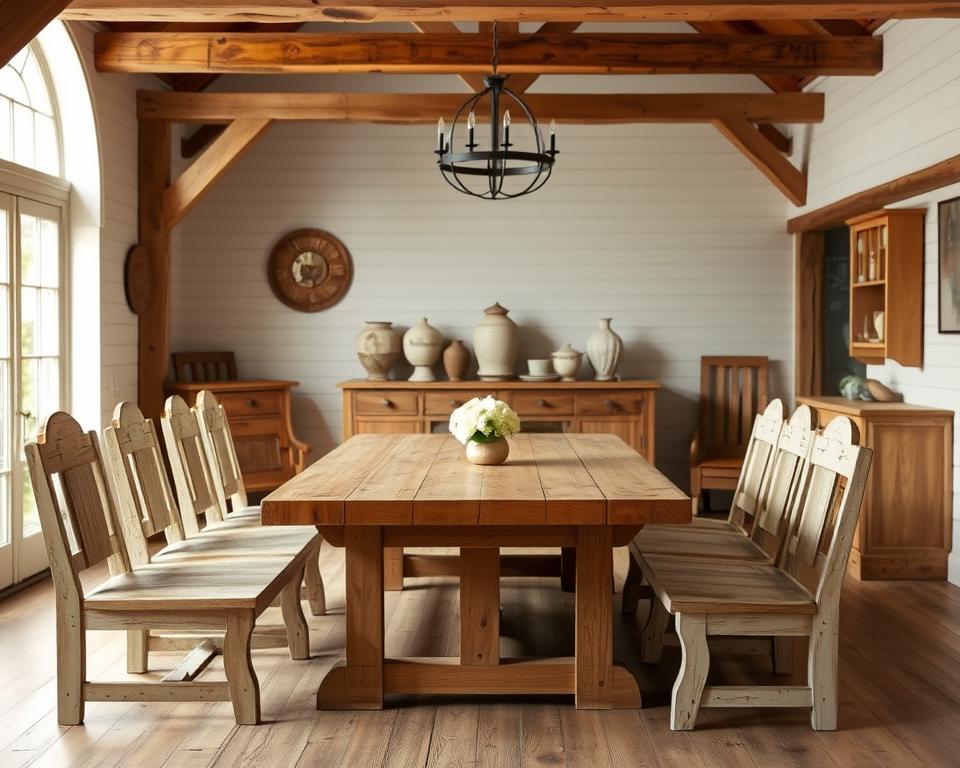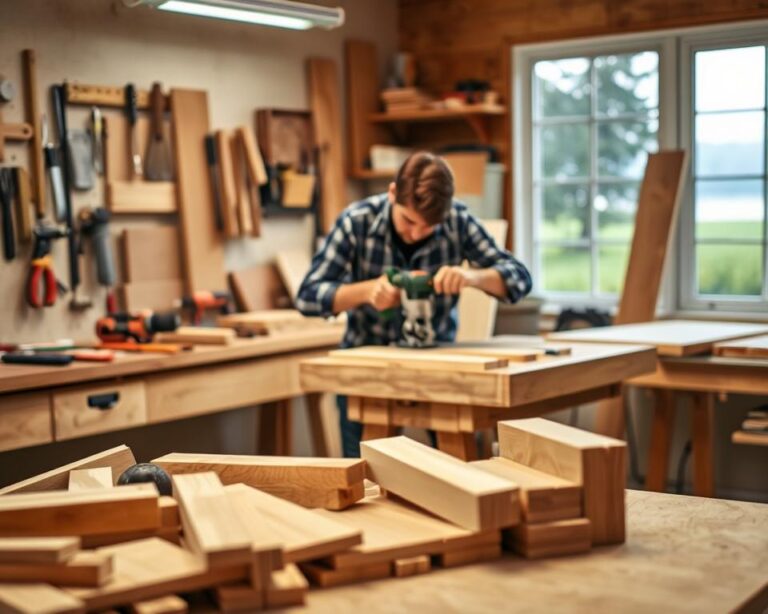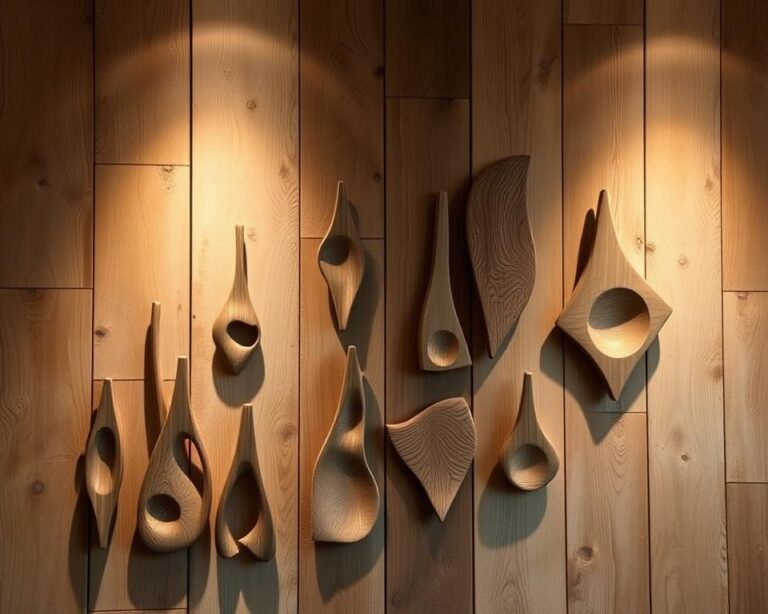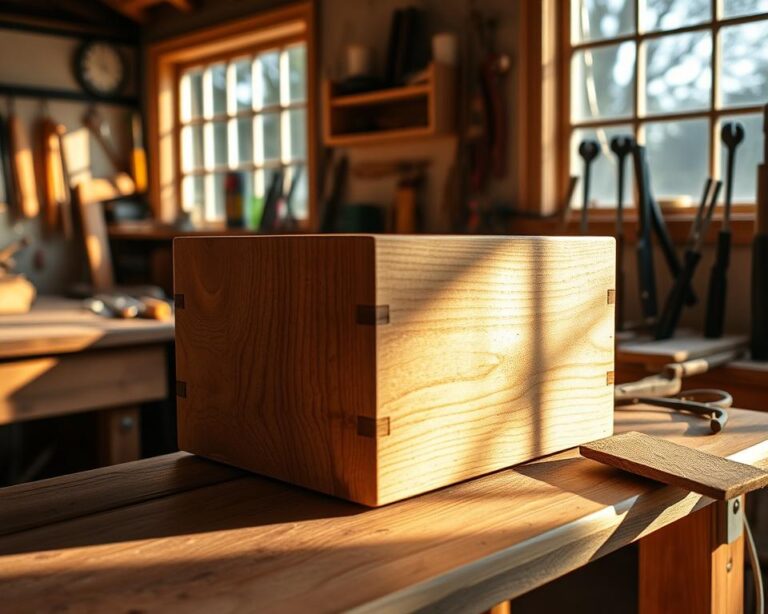The farmhouse style is now a favorite for 93% of homeowners. It mixes old charm with modern touches. By using your creativity and cost-effective strategies, you can turn your place into a sanctuary of budget-friendly farmhouse decor.
Adding DIY wood furniture in your home brings a special farmhouse vibe without spending a lot. Thanks to Joanna and Chip Gaines, this look is both trendy and doable for DIY lovers. Whether you’re a newbie or a seasoned DIYer, this guide helps you make beautiful, custom farmhouse wood furniture that’s affordable.
Understanding Farmhouse Style: Key Features
Farmhouse style mixes rustic charm, calming looks, and useful design. It takes from old styles but adds a modern touch for a warm feeling. You’ll see rustic parts, simple colors, and practical designs that make a place feel cozy.
Rustic Elements
Farmhouse style’s heart is in natural materials. Most rustic furniture is made from reclaimed wood, bringing warmth and personality. Old accessories and rough textures bring back memories. Mixing rustic metal with wood adds a modern spin. Open shelves and detailed carvings add to the decor’s charm.
Neutral Color Palette
Farmhouse decor loves neutral colors. Whites, grays, and beiges make everything look calm. This lets natural elements stand out. Use wood stains or paints to showcase the natural wood. Vintage looks with small flaws add to the style.
Functional Design
In farmhouse style, furniture must be practical and beautiful. It focuses on flexibility, with pieces that are useful and look great. Items should have many uses. Adding a rustic wall magazine rack can make your space better. For how to make one, visit this guide.
Getting Started with DIY Wood Furniture
Starting DIY wood furniture projects is exciting. You need proper tools and materials to make your ideas real. Good tools improve your work speed and make things easier. It’s important to know about different woodworking materials. Picking the right stuff for your project’s needs, budget, and style matters a lot.
Tools and Materials You’ll Need
Before you begin, collect these tools and materials:
- Saws (circular saw, hand saw)
- Drills and drill bits
- Screws and nails
- Sandpaper and sanding blocks
- Wood glue
- Measuring tape and square
- Wood types (pine, oak, plywood, etc.)
High-quality DIY tools make your work smoother. They help make strong, good-looking furniture.
Safety Precautions to Consider
Safety is key in DIY projects. To stay safe, remember these tips:
- Always wear protective eyewear to shield your eyes from debris.
- Use ear protection when operating loud machinery.
- Keep your workspace organized to avoid accidents.
- Be cautious with sharp tools to prevent cuts.
- Read and follow the instructions for each tool you use.
By following these safety tips, you ensure a safe space for your creativity.
Selecting the Right Wood for Your Projects
Choosing the right wood for your farmhouse furniture is key to its durability and look. Every wood type brings different qualities that affect your work and the furniture’s final appearance. By knowing the most popular woods and their features, you can pick the best one for your project.
Types of Wood for Farmhouse Furniture
- Pine: A top pick for DIYers, pine is light and won’t break the bank. It’s ideal for a rustic vibe, adding warmth to any space.
- Oak: Oak is tough and lasts long, giving off an elegant appearance. Though it costs more than pine, it’s worth it for its durability and classic look.
- Reclaimed Wood: Choosing reclaimed wood means you’re helping the planet. Plus, it gives furniture a special, old-time charm. Reclaimed pieces often have nicks and scratches that add to their story.
Pros and Cons of Each Type
| Type of Wood | Pros | Cons |
|---|---|---|
| Pine | Affordable, lightweight, easy to work with | Not as tough as other woods |
| Oak | Very strong, beautiful grain, lasts for years | Costs more, heavier to move |
| Reclaimed Wood | Good for the environment, unique look, tells a story | Harder to find and prep for use |
Budgeting for Your DIY Projects
Managing your budget well is key when creating farmhouse furniture affordably. Knowing how to precisely estimate costs helps avoid unexpected surprises. By planning every stage well, you make sure your DIY projects are both fun and financially manageable.
Estimating Costs Accurately
Before you begin, make a comprehensive list of all the materials you’ll need. This includes things like wood, hardware, and supplies for finishing. Being accurate in your cost estimates helps steer clear of unplanned expenses. Here’s how you might break down your costs:
| Item | Estimated Cost |
|---|---|
| Wood | $150 |
| Hardware | $30 |
| Finishes | $25 |
| Total | $205 |
Cost-Saving Tips
Opting for cost-effective projects can greatly reduce your spending. Here are some smart strategies:
- Utilize reclaimed materials: Look for wood and other supplies at salvage yards or on local online marketplaces.
- Compare prices: Visit various stores or check online to find the best deals on what you need.
- Leverage free online tutorials: There are lots of blogs and video channels that offer free detailed plans.
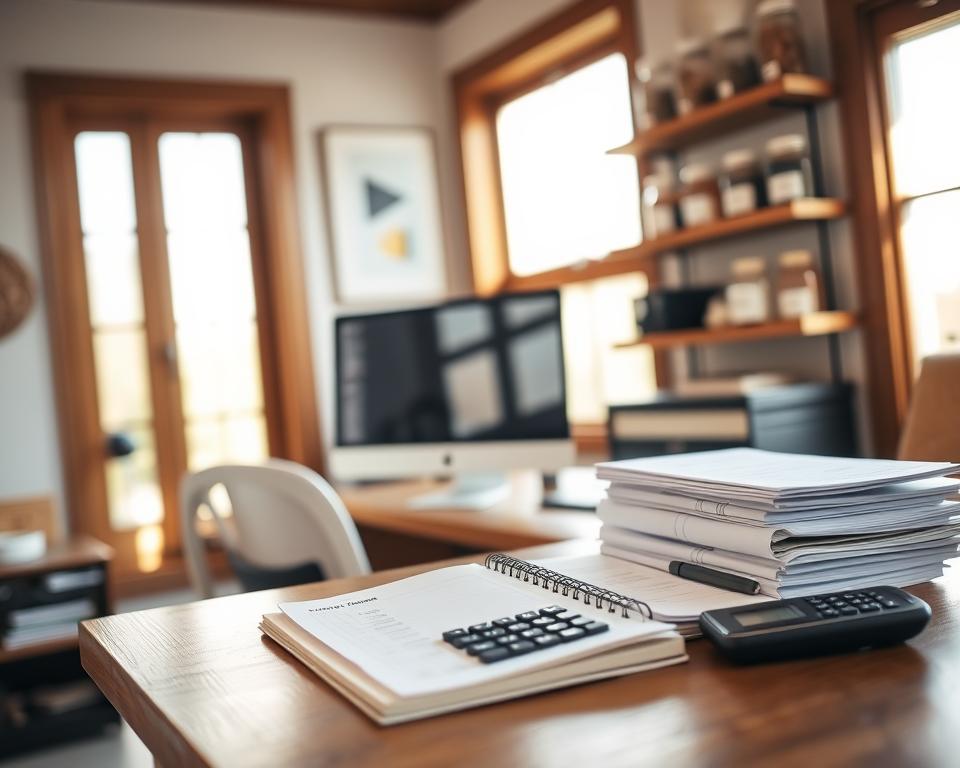
Popular DIY Farmhouse Wood Furniture Projects
Exploring DIY projects for farmhouse wood furniture can change your living area. It allows you to be creative. These projects make your home unique and show off your style. Think about trying these three projects that are famous for their beauty and usefulness.
Reclaimed Wood Table
Making a reclaimed wood table is perfect for any dining room. It uses sustainable materials and has a special charm. You can make your table in different sizes. This is great for both big family meals and small dinners. It’s a project that highlights your woodworking skills and gives you a sturdy table that gets better with age.
Rustic Bookshelves
Rustic bookshelves are useful and make your home look better. Use rustic wood to display books, decorations, and photos. You can fit this DIY project into any space. It can be an empty wall in your living room or a small corner in your bedroom. Making bookshelves lets you decide on their size and the design of the shelves. It’s a great addition to your home.
Farmhouse Bench
A farmhouse bench is great for an entryway or dining room. It can be used for sitting while putting on shoes or for extra seats at dinner. You can choose colors and fabrics to match your home’s look. Making a farmhouse bench is a fun project that makes your space better.
Step-by-Step Guide to Building a Farmhouse Table
Building a farmhouse table yourself is exciting and rewarding. You need the right plans and some patience. Gather all materials first, including a cut list and precise dimensions. This makes DIY table building simpler.
Gathering Your Materials
Get all materials before you start. You will need:
- Wood boards (for the tabletop, legs, and apron)
- Wood screws
- Wood glue
- Sandpaper (various grits)
- Wood stain or paint (for finishing)
- Measuring tape
- Power drill
- Saw (circular or miter saw recommended)
Having these items means no interruptions. You can smoothly follow the woodworking guides.
Assembly Instructions
With all materials ready, start building your table. Follow these steps:
- Measure and cut the wood as per your plans. Check sizes for accuracy.
- Glue the boards for the tabletop. Use screws for a firm hold.
- Build the apron with shorter boards around the tabletop edges for support.
- Screw the legs at each apron corner. Check for level and solidity.
- Sand the piece well, getting it ready for the finish.
- Apply your chosen finish. Let it dry as instructed.
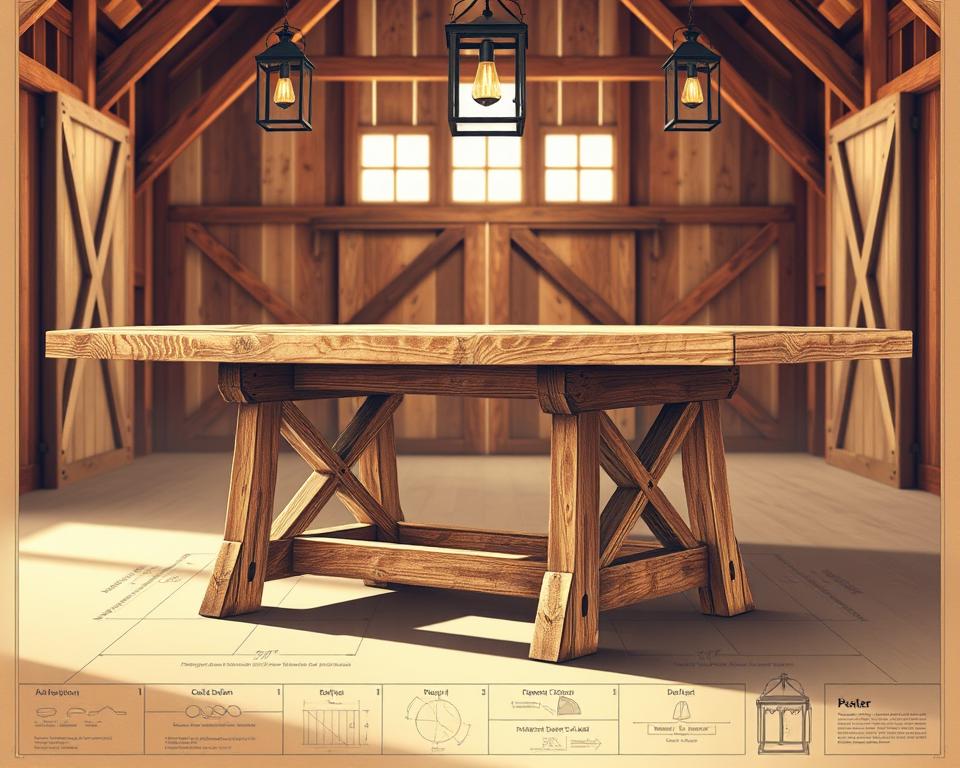
This process turns raw materials into a charming, rustic table. It reflects farmhouse living’s beauty. Enjoy the DIY table building journey!
Personalizing Your Pieces
Customizing your furniture involves key techniques like painting and staining. These methods help you get the look you want for your DIY farmhouse projects. You can pick from many options to boost both the look and the function, making your style stand out.
Painting and Staining Techniques
Chalk paint is a favorite for DIY lovers because it’s easy to use and has a nice matte look. It sticks well to different surfaces, which is great for your projects. Staining highlights wood’s natural beauty and adds protection. Picking the right stain can make your wood’s grain look even better, giving it a classic vibe. Trying out these painting and staining ways helps you find the mix that fits your style best.
Adding Unique Finishing Touches
Adding special farmhouse finishes makes your furniture unique. Think about redoing hardware for a new look or adding cushions for comfort and color. Features like stenciled patterns or custom engravings boost the style, making pieces that really show your personality. Each extra touch makes your creations more charming and useful, so they’re not just nice to look at but also serve a purpose.
| Technique Type | Description | Benefits |
|---|---|---|
| Chalk Paint | Matte finish, easy to apply on various surfaces | Rapid application, no primer needed |
| Staining | Enhances wood grain, adds protection | Provides a natural look, durable finish |
| Refinishing Hardware | Updating knobs and handles | Cost-effective, freshens up the appearance |
| Adding Cushions | Uplifting aesthetic and comfort | Personalizes the furniture, increases usability |
Maintaining Your Farmhouse Wood Furniture
Keeping wood furniture in top shape is key to preserving its beauty and value. We’ll share easy cleaning and repair tips for your unique pieces. These tips ensure your handcrafted furniture stays stunning for years.
Cleaning Tips
Choosing the right cleaning methods is crucial. Use mild soap and water with a soft cloth for a gentle clean. Steer clear of too much water to avoid warping the wood. Here are tips to keep your furniture looking great:
- Dust often with a microfiber cloth to stop dirt buildup.
- Apply a wood polish made for wood furniture upkeep.
- Quickly clean spills to dodge stains.
Repairing Damage
Even high-quality pieces can show signs of wear and tear. Knowing how to fix furniture can greatly prolong its life. Use wood filler or polish for minor scratches. For loose joints, wood glue or brackets can help. Check out these repair ideas:
- Use a wood stain or touch-up pen for scratches.
- For wobbly joints, apply wood glue and clamp until it’s dry.
- Update worn hardware with new hinges or knobs.
Caring for farmhouse wood furniture takes effort and commitment. But, the payoff is huge. By maintaining its beauty and functionality, these pieces will be cherished for many generations.
Inspiration and Resources for Your DIY Journey
Starting to make your own farmhouse-style furniture is really exciting. It’s important to find the right inspiration and resources to keep going. Meeting people who like the same things can make your projects even better. You can learn a lot and share what you know. Online groups and forums are great places to find new ideas and show off what you’ve made. This keeps the DIY spirit alive.
Online Communities and Forums
Being part of online DIY forums can teach you a lot. These places are all about helping each other out. You can share your work, get advice, and learn from others. Places like a Facebook group for farmhouse decor or Reddit’s DIY community are full of people ready to help. You’ll get tips to make your projects look amazing.
Recommended Books and Blogs
Reading books and blogs about farmhouse decor is super helpful. Lots of experts share what they know, from simple woodworking to fixing up furniture. You’ll find cool project ideas and learn a lot. This can really improve your DIY skills. Exploring these resources will help you find your own style and make your farmhouse furniture dreams come true.

